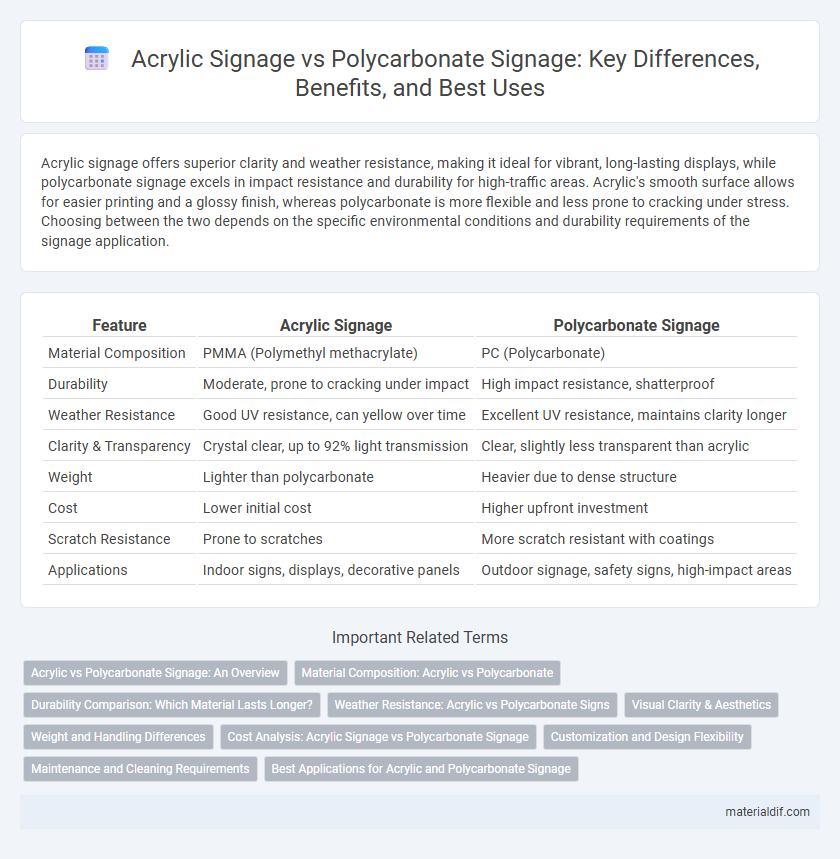Acrylic signage offers superior clarity and weather resistance, making it ideal for vibrant, long-lasting displays, while polycarbonate signage excels in impact resistance and durability for high-traffic areas. Acrylic's smooth surface allows for easier printing and a glossy finish, whereas polycarbonate is more flexible and less prone to cracking under stress. Choosing between the two depends on the specific environmental conditions and durability requirements of the signage application.
Table of Comparison
| Feature | Acrylic Signage | Polycarbonate Signage |
|---|---|---|
| Material Composition | PMMA (Polymethyl methacrylate) | PC (Polycarbonate) |
| Durability | Moderate, prone to cracking under impact | High impact resistance, shatterproof |
| Weather Resistance | Good UV resistance, can yellow over time | Excellent UV resistance, maintains clarity longer |
| Clarity & Transparency | Crystal clear, up to 92% light transmission | Clear, slightly less transparent than acrylic |
| Weight | Lighter than polycarbonate | Heavier due to dense structure |
| Cost | Lower initial cost | Higher upfront investment |
| Scratch Resistance | Prone to scratches | More scratch resistant with coatings |
| Applications | Indoor signs, displays, decorative panels | Outdoor signage, safety signs, high-impact areas |
Acrylic vs Polycarbonate Signage: An Overview
Acrylic signage offers superior clarity and UV resistance, making it ideal for outdoor displays requiring vibrant colors and long-lasting visibility. Polycarbonate signage provides enhanced impact resistance and durability, suited for high-traffic or vandalism-prone environments where strength is critical. Choosing between acrylic and polycarbonate signage depends on specific needs for transparency, weather resistance, and toughness in various commercial applications.
Material Composition: Acrylic vs Polycarbonate
Acrylic signage is made from polymethyl methacrylate (PMMA), offering excellent clarity, UV resistance, and surface hardness, making it ideal for outdoor displays. Polycarbonate signage consists of a thermoplastic polymer known for its superior impact resistance, higher heat tolerance, and greater flexibility compared to acrylic. While acrylic provides a glass-like appearance with better scratch resistance, polycarbonate excels in durability and impact strength, making it suitable for high-traffic or vandal-prone environments.
Durability Comparison: Which Material Lasts Longer?
Acrylic signage offers excellent weather resistance and UV stability, making it suitable for long-term outdoor use; however, polycarbonate signage surpasses acrylic in impact resistance and shatterproof qualities, enhancing its durability in high-traffic or vandal-prone areas. Polycarbonate's superior toughness allows it to withstand extreme temperatures and physical stress without cracking, extending its lifespan beyond that of acrylic under harsh environmental conditions. When longevity in demanding settings is prioritized, polycarbonate signage generally outperforms acrylic due to its enhanced strength and resilience.
Weather Resistance: Acrylic vs Polycarbonate Signs
Acrylic signage offers excellent weather resistance with high UV stability, preventing yellowing and maintaining clarity over time in outdoor conditions. Polycarbonate signs provide superior impact resistance but are more prone to surface scratching and yellowing when exposed to prolonged sunlight. For long-term outdoor durability, acrylic signs typically outperform polycarbonate in resisting weather-related degradation.
Visual Clarity & Aesthetics
Acrylic signage offers superior visual clarity with a light transmittance of up to 92%, making colors appear more vibrant and designs more striking compared to polycarbonate. Polycarbonate signs, though tougher and more impact-resistant, tend to yellow and lose transparency over time, diminishing aesthetic appeal. Acrylic's smooth, glass-like finish provides a premium look ideal for high-end branding and indoor displays.
Weight and Handling Differences
Acrylic signage is significantly lighter than polycarbonate, making it easier to handle and install in various environments. Polycarbonate, while heavier, offers enhanced durability and impact resistance, which is ideal for high-traffic or outdoor applications. The weight difference directly influences transportation costs and labor efficiency during installation projects.
Cost Analysis: Acrylic Signage vs Polycarbonate Signage
Acrylic signage typically costs less than polycarbonate signage, making it a budget-friendly option for businesses prioritizing affordability. Polycarbonate signage offers superior impact resistance and durability but comes at a higher price point, reflecting its enhanced performance in demanding environments. The choice between acrylic and polycarbonate signage hinges on balancing upfront material costs with longevity and maintenance expenses.
Customization and Design Flexibility
Acrylic signage offers superior customization and design flexibility compared to polycarbonate, allowing for precise laser cutting, vibrant printing, and a smooth, glossy finish that enhances visual appeal. Acrylic sheets come in various colors, thicknesses, and transparencies, enabling tailored sign solutions for diverse branding needs. Polycarbonate signage, while more impact-resistant, typically lacks the same level of surface smoothness and clarity required for intricate designs and high-quality graphics.
Maintenance and Cleaning Requirements
Acrylic signage demands gentle cleaning with non-abrasive, ammonia-free solutions to prevent surface scratches and maintain clarity, while polycarbonate signage offers greater resistance to impacts and chemicals, allowing for more robust maintenance routines. Both materials benefit from regular dusting, but polycarbonate's superior durability reduces the frequency and intensity of cleaning required. Proper maintenance extends the lifespan of acrylic and polycarbonate signage, ensuring long-lasting visual appeal in outdoor and indoor settings.
Best Applications for Acrylic and Polycarbonate Signage
Acrylic signage excels in indoor applications such as retail displays, office signs, and menu boards due to its crystal-clear transparency and smooth surface that enhances vibrant color printing. Polycarbonate signage is ideal for outdoor environments and high-impact areas like construction sites and transportation hubs, offering superior durability, UV resistance, and impact strength. Choosing acrylic for aesthetic clarity and polycarbonate for toughness ensures optimal performance tailored to specific environmental demands.
Acrylic Signage vs Polycarbonate Signage Infographic

 materialdif.com
materialdif.com